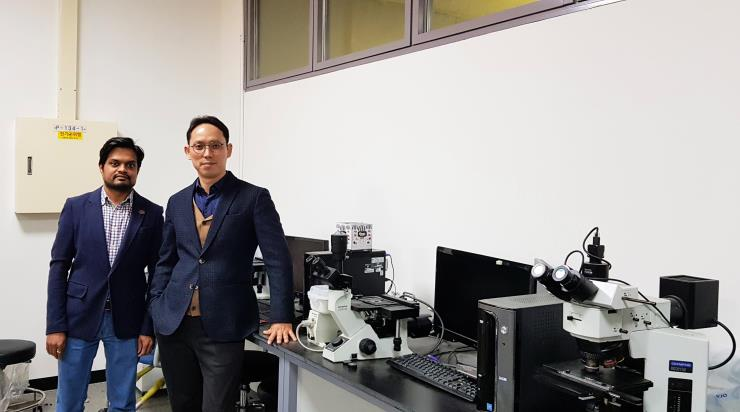- About Ajou
- Admission
- Academics
- Research
-
International
International
- Campus Life
-
News and Event
News and Event
- AUT
Major Research Result
NEW Prof. Seo Hyung-tak Develops Highly-efficient Solar Water-splitting Photocatalyst Electrode
- 2021-07-01
- 6811

A team of researchers led by Prof. Seo Hyung-tak, from the Department of Materials Science and Engineering at Ajou University, has succeeded in developing water-splitting photocatalyst electrodes for hydrogen production. This breakthrough is expected to be useful in producing low-cost, high-efficiency photoelectrodes for hydrogen production in a non-polluting way.
Prof. Seo Hyung-tak (pictured right) announced successful development of high-efficiency solar, water-splitting photocatalyst electrodes. The achievement was published online and entitled, “Enhanced solar water-splitting of an ideally doped and work function tuned {002} oriented one-dimensional WO3 with nanoscale surface charge mapping insights,” in Applied Catalysis B: Environmental (Impact Factor 16.683), an international journal, on May 6. Prof. Shankara S. Kalanur (pictured left), from the Department of Materials Science and Engineering, participated in the joint research as first author.
The range of possible applications of hydrogen as an alternative source of energy for automobiles, electricity generation, and other industries has been expanding rapidly as of late. In order to produce hydrogen for such purposes, including fuel cells, reforming is the most common process. During the process, an amount of CO2 equivalent to nine times more than the hydrogen production weight is emitted.
In an effort to reduce CO2 emissions, there is a fast-growing body of research worldwide to develop a solar, water-splitting technology using electricity and solar energy. Through water-splitting with the use of electric charges while inserting solar energy into semiconductor photocatalyst electrodes, CO2-free hydrogen is made. However, this process is a relatively low-efficiency form of production compared to existing fuel cell reforming methods.
Therefore, improving the light reactions of photocatalyst electrodes, a major component in the solar water-splitting system, while securing long-term response durability is critical. Recently, photocatalyst electrodes have proven to be somewhat limited in achieving technological advancement; thus, a growing number of studies are now underway to develop tandem photocatalytic electrodes. However, the tandem structure makes the process complex, lowering the reproducibility of electrodes while triggering chemical instability between different materials.
Under these circumstances, the team focused on tungsten trioxide (WO3) electrodes, which have been widely studied, but faced obstacles in terms of efficiency. Instead of using the two-component layered structure, Prof. Seo found that one-dimensional tungsten trioxide nanorods could be aligned with {002}, with high photocatalytic activities when a small amount (1.14%) of Yttrium (Y) is doped. To find optimal doping concentrations and processing, dozens of impurity concentrations were tested.
Of particular note is that Yttrium(Y)-doped tungsten trioxide (WO3) showed an increase of up to 200% in photoelectric current, while the conversion efficiency of photoelectric currents into hydrogen was nearly 95 percent. Through a minimum amount of doping, various physical and chemical changes, including resistance reduction, changes in electronic structure, and changes in surface work function, were identified.
Dr. Seo explained: “It is significant that even with the doping of minimum impurities into low-cost tungsten trioxide, nanostructured photocatalyst electrodes were made using high-efficiency, single-material elements. This made for highly-efficient conversion during the hydrogen production process. Our team is committed to ensuring its safety for commercial uses in the future.”
The study was sponsored by the Research Support Program for New Researchers with Advanced Overseas Accomplishments, the Basic Research Support Program from the Ministry of Science and ICT and the National Research Foundation of Korea.
